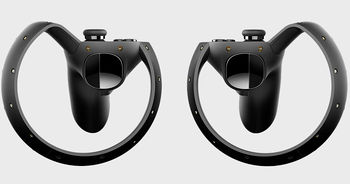Difference between revisions of "Oculus Touch"
Xinreality (talk | contribs) |
Xinreality (talk | contribs) |
||
| Line 60: | Line 60: | ||
===Tracking=== | ===Tracking=== | ||
| − | Oculus Touch achieves precise, low latency, 6[[DOF]] tracking through the same system as the [[Rift]] headset. IR LEDs are placed on the controllers' bodies and rings, allowing them to be tracked by the same [[positional tracking sensor]] that tracks the [[HMD]]. In addition to [[positional tracking]], controllers possess built-in [[IMU]]s that allow [[rotational tracking]]. | + | Oculus Touch achieves precise, low latency, 6[[DOF]] tracking through the same system as the [[Rift]] headset. IR LEDs are placed on the controllers' bodies and rings, allowing them to be tracked by the same [[positional tracking sensor]] that tracks the [[HMD]]. The LEDs on the outer rings prevent [[occlusion]] caused by your hands. In addition to [[positional tracking]], controllers possess built-in [[IMU]]s that allow [[rotational tracking]]. |
===Gesture Sensing=== | ===Gesture Sensing=== | ||
| Line 66: | Line 66: | ||
===Ergonomics=== | ===Ergonomics=== | ||
| − | + | You grip the controller similar to how you shake someone's hand. Your thumb is placed on top of the controller and handles the analog stick and 2 buttons. Your index finger is placed in front and activates a trigger. Your other 3 fingers grip the handle of the controller with your middle finger responsible for a trigger on the side. | |
| + | |||
==Apps== | ==Apps== | ||
Revision as of 08:17, 27 June 2015
| Oculus Touch | |
|---|---|

| |
| Basic Info | |
| Type | Input Device, Motion Tracker |
| Subtype | Hands/Fingers Tracking, Haptics |
| Platform | Oculus Rift |
| Developer | Oculus VR |
| Release Date | First half 2016 |
| Website | https://www.oculus.com/en-us/rift/ |
| System | |
| Operating System | Windows, Mac, Linux |
| Storage | |
| Display | |
| Image | |
| Optics | |
| Tracking | |
| Tracking | 6DOF |
| Rotational Tracking | IMUs |
| Positional Tracking | External camera sensor |
| Audio | |
| Connectivity | |
| Device | |
| Input | Analog stick, 2 buttons, 2 triggers, hand gestures |
Oculus Touch was revealed alongside Oculus Rift CV1, on June 11, 2015 during Oculus VR's Pre-E3 Special Live Event.
Contents
Features
- Hand presence - the controller naturally fit the resting state of your hand.
- Manipulation - precise manipulation of virtual objects with both positional and rotational tracking.
- Low mental load
- Communicative gestures - for social interactions.
- Transitional inputs - gamepad inputs such as analog stick, buttons and triggers
- Lightweight -
Hardware
Traditional Controls
One wireless Oculus Touch is held in each hand. 2 Oculus Touch controllers are designed to operate simultaneously. Some of the controller's features are similar to that of a traditional gamepad. It has 1 analog stick and 2 buttons on top and 2 triggers, 1 for the index finger located in front and 1 for the middle finger on the side.
Tracking
Oculus Touch achieves precise, low latency, 6DOF tracking through the same system as the Rift headset. IR LEDs are placed on the controllers' bodies and rings, allowing them to be tracked by the same positional tracking sensor that tracks the HMD. The LEDs on the outer rings prevent occlusion caused by your hands. In addition to positional tracking, controllers possess built-in IMUs that allow rotational tracking.
Gesture Sensing
The device has an inward facing sensor matrix that can detect hand gestures.
Ergonomics
You grip the controller similar to how you shake someone's hand. Your thumb is placed on top of the controller and handles the analog stick and 2 buttons. Your index finger is placed in front and activates a trigger. Your other 3 fingers grip the handle of the controller with your middle finger responsible for a trigger on the side.
Apps
Developer
History
Oculus Touch's codename while in development was Half Moon.